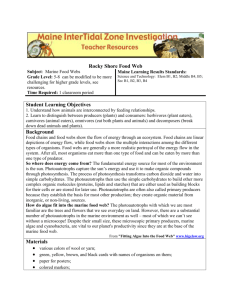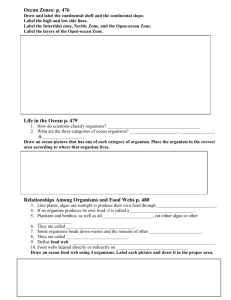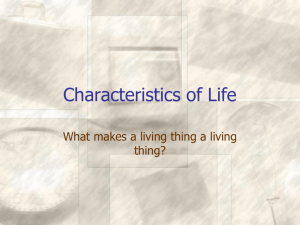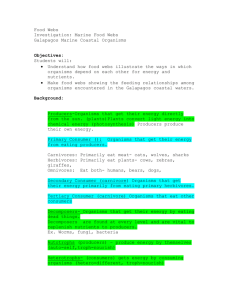PDF version
advertisement
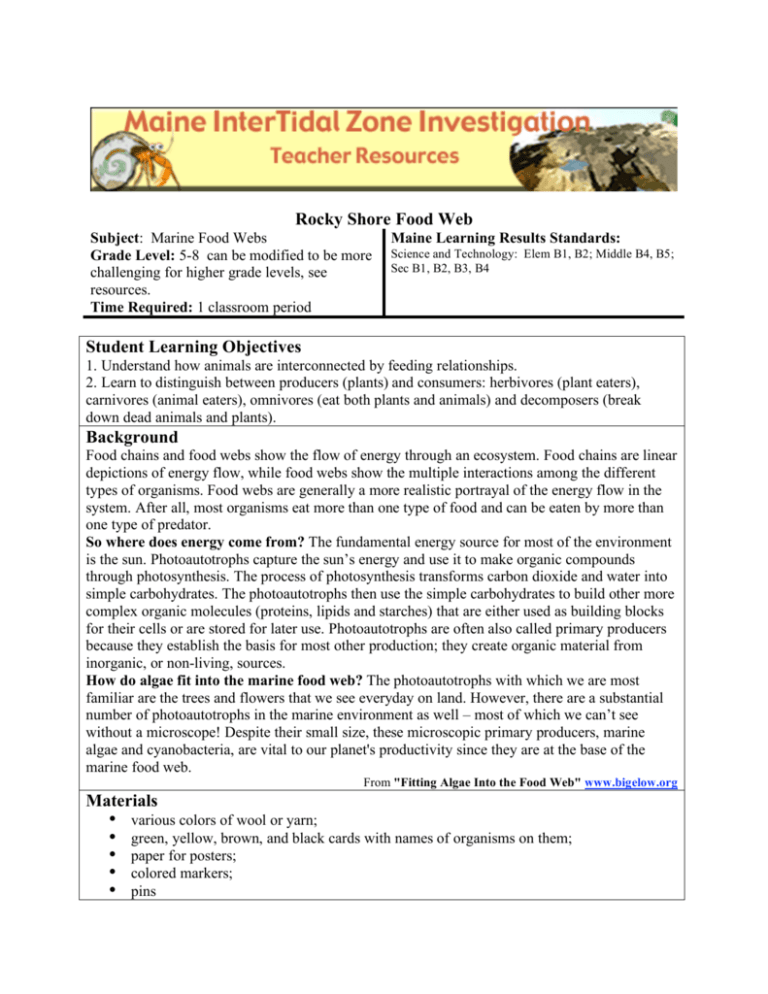
Rocky Shore Food Web Subject: Marine Food Webs Grade Level: 5-8 can be modified to be more challenging for higher grade levels, see resources. Time Required: 1 classroom period Maine Learning Results Standards: Science and Technology: Elem B1, B2; Middle B4, B5; Sec B1, B2, B3, B4 Student Learning Objectives 1. Understand how animals are interconnected by feeding relationships. 2. Learn to distinguish between producers (plants) and consumers: herbivores (plant eaters), carnivores (animal eaters), omnivores (eat both plants and animals) and decomposers (break down dead animals and plants). Background Food chains and food webs show the flow of energy through an ecosystem. Food chains are linear depictions of energy flow, while food webs show the multiple interactions among the different types of organisms. Food webs are generally a more realistic portrayal of the energy flow in the system. After all, most organisms eat more than one type of food and can be eaten by more than one type of predator. So where does energy come from? The fundamental energy source for most of the environment is the sun. Photoautotrophs capture the sun’s energy and use it to make organic compounds through photosynthesis. The process of photosynthesis transforms carbon dioxide and water into simple carbohydrates. The photoautotrophs then use the simple carbohydrates to build other more complex organic molecules (proteins, lipids and starches) that are either used as building blocks for their cells or are stored for later use. Photoautotrophs are often also called primary producers because they establish the basis for most other production; they create organic material from inorganic, or non-living, sources. How do algae fit into the marine food web? The photoautotrophs with which we are most familiar are the trees and flowers that we see everyday on land. However, there are a substantial number of photoautotrophs in the marine environment as well – most of which we can’t see without a microscope! Despite their small size, these microscopic primary producers, marine algae and cyanobacteria, are vital to our planet's productivity since they are at the base of the marine food web. From "Fitting Algae Into the Food Web" www.bigelow.org Materials • various colors of wool or yarn; • green, yellow, brown, and black cards with names of organisms on them; • paper for posters; • colored markers; • pins Activity Procedure 1. Each person chooses or is assigned a component of a coastal habitat. 2 .People are assigned cards according to what part of the habitat they are. A yellow card for the sun, green cards for the plants, and for the consumers: brown cards for the herbivores, black cards for the carnivores, and blue cards for the omnivores. Decide what plants and animals to use as producers, herbivores, carnivores, decomposers and omnivores. Here are some examples for the rocky shore: Once participants have chosen their organisms they can do research on their animals: • Make a sketch of your organism. • Where does the animal live? • What does it need to live, i.e. what are its habitat requirements? • What does it eat (prey on)? (How does it eat?) • What organisms eat it? • What organisms does it live with? Hint: If you have 20 participants you should have at least five producers. For proper representation of an ecosystem, producers are more numerous and are also your building blocks of life. 3. Start off with the question, 'What is the most essential thing for life on the planet Earth?' The sun is.... The person who is the sun holds onto one end of a ball of wool. The wool could be coloured green to represent photosynthesis. 4. Next ask who needs sunshine? Plants use the sunshine for photosynthesis. The ball of wool is passed to the other person who is a type of plant, while the sun hangs on. 5. Continue the game in the same fashion, developing a web of interconnecting wool. You can change the colour of the wool to brown when you reach herbivores if you like. 6 .Once the web is made, ask everybody what they have made-a food web. 7. Next, introduce a disturbance like a toxin that kills plant life. Students who are the plants pull on their piece of wool, those who feel the pull raise their hands. This illustrates that if one organism is affected in a community, other creatures may become affected as well. VARIATION 1: A poster of a coastal ecosystem can be put up on the wall. The designs of people's organisms are placed in the right spots within the habitat. Food webs can then be developed by connecting the designs using pins and wool. VARIATION 2: For a more physically active webbing exercise, try this one. With a food web posted on the wall for everyone to see, assign each organism a sound. Here are examples of sounds: 5 algae: repeat the word 'green' (for making food) 5 zooplankton: zoop, zoop 2 birds: chirp 2 crabs: clap your hands 2 fish: swish, swish 2 oysters: filter, filter 2 snails: munch, munch 1 human: quiet Post these on the wall with the proposed food web. 1. Each person learns their sound. 2. Learn the sounds of your prey. 3. Unfortunately plants cannot move during the activity. 4. Everybody circulates slowly looking for food but is careful not to be eaten. Hint: People should not reveal who they are. 5. On being touched (i.e. eaten), the person must give up their name card and withdraw to the boundary. 6. Continue until there is nothing left to eat. 7. Ask for suggestions from the group to improve the activity, or change organisms. Resources For an interactive computer based lesson on Marine Food Webs, visit "Fitting Algae Into the Food Web" at www.bigelow.org/edhab For older students, the topic of toxins in the food chain could be introduced and the resulting affects on coastal ecosystems. See www.bigelow.org/edhab for lesson ideas. Vocabulary Carnivore- A meat-eating animal. Community- A naturally occurring group of plants and animals that live within a certain environment and interact with each other. Decomposer- An organism which gains energy by breaking down the final remains of living things. Ecology-The study of the physical and biological interactions between an organism and its natural environment Food chain-A linear sequence of organisms that exist on successive trophic levels within a natural community, through which energy is transferred by feeding. Food web-A non-linear network of feeding between organisms that includes many food chains and multiple organisms on each trophic level. Habitat- The immediate space where an animal or plant lives and has food, water and protection. Herbivores- A plant-eating animal. Heterotroph- An organism that is unable to synthesize organic compounds (and thus its energy) from the environment and therefore fulfils its energy requirements by feeding on other organisms. Omnivores- An organism that eats both plants and animals. Photoautotroph-An organism that synthesizes organic molecules from inorganic starting materials through photosynthesis or chemosynthesis. Autotrophs are ecologically important as primary producers as they ultimately provide energy for all heterotrophic organisms. Primary Consumer: A heterotrophic, herbivorous organism that feeds directly on a primary producer. Urchins are a primary consumer as they feed on kelp. Primary Producer: An autotrophic organism that makes complex organic compounds from inorganic compounds through the process of photosynthesis or chemosynthesis. Adapted from “Water Webs in Action,” By the Sea, An Educational Resource for Science Teachers in Atlantic Canada, Jim Wheldon.
